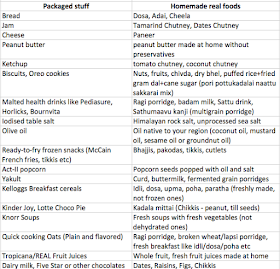A few days back, my husband and I had this conversation:
Some of my past blogposts from where you can pick up a few ideas:
10+ dry snack options for 5 PM hunger pangs at work
30+ quick snack ideas for summer vacation demands
How to reduce eating junk foods
Me: My next post is on brown bread.
Husband: WHAT? Isn’t brown bread healthy?
Me: Wait for my post. You’ll know. *laughs*
Husband: Because of your posts, I’m not able to buy anything from the supermarket. Please don’t write about Pringles, I beg you!
A friend remarked, “Why do you keep writing “don’t eat this, don’t eat that” always? What should we eat then?"
Someone who had read my post posted a comment - "At this rate we'll have to stop eating food altogether”.
In the last 20 years, our understanding of food is completely taken over by packaged stuff - the so-called edible material manufactured in a factory using numerous synthetic chemicals and eaten out of plastic packets.
I’m sorry I cannot place such products under the category of “foods”. Food is supposed to nourish us, give us energy, make us stronger and enable us to execute our life purpose. All that packaged foods have ever done is take us on a path of health destruction, driven by profit motives of food corporations and pharma companies.
I’m an 80s girl and I have lived a small but significant part of my formative years in the pre-globalisation era in a small town. I'm so grateful to have experienced the other side, where fresh homemade food was the norm.
There are plenty of foods that you can eat, if you shift your focus outside the processed/packaged foods section.
 |
| Fruit Basket at my home |
1) Take a look at your kitchen pantry. Make a list of all those packs/bottles/jars of packaged foods you have stocked up. What does the total number add up to? Do this exercise once in 15 days or once a month. Try to reduce this number every month.
2) Increase your fruits intake. Ever since I stopped buying packaged snacks 4-5 years back, my kitchen is always stocked up with fruits. I buy fruits atleast 2 times a week. Not the exotic kiwis or avocados. But the bananas, chikkus, guavas, pineapples, papayas, seasonal fruits such as Shimla apples, pomegranates, mangoes, Coorg/Nagpur oranges etc. My 6-year old daughter eats all fruits since she has started this habit of eating fruit every single day from the time she was a toddler.
3) Stock up on dry fruits and nuts. My husband loves cashews and whenever he feels like munching something, he grabs a handful of plain cashews. We don’t stock up on chocolates, cookies or namkeen anymore.
4) In each of my post on packaged foods, I try to list down healthy alternatives for the same. Here’s a handy compilation of such real foods that will help you get rid of packaged junk:
Aren’t there enough options available?
Some of my past blogposts from where you can pick up a few ideas:
10+ dry snack options for 5 PM hunger pangs at work
30+ quick snack ideas for summer vacation demands
How to reduce eating junk foods
The next time you go shopping to a store or order groceries online, try cutting down on all ready-to-eat packaged junk. There are many people who lead happy, healthy and busy lives without relying on packaged foods.
“Where there is a will, there is a way”.
Options are aplenty if you consciously take a step towards a packaged food-free life. Please do share your ideas for healthy substitutes in place of packaged junk. Will add it to the table above.







